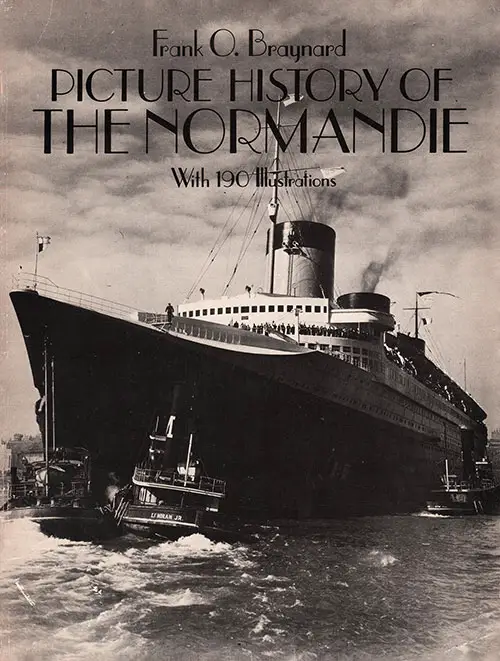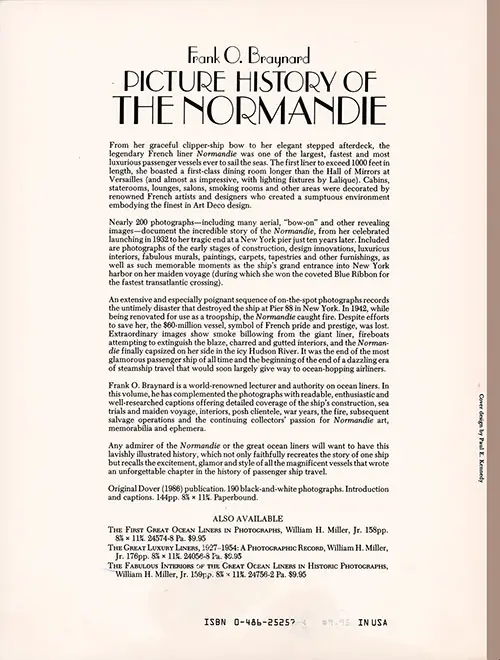Picture History of The Normandie

Front Cover, Picture History of The Normandie With 190 Illustrations by Frank O. Braynard, 1987. | GGA Image ID # 2048424d56
From the Author
Everyone knew that the interior of the new French ship would be just as revolutionary—perhaps even more so—than that of the Ile de France (completed in 1927 and a milestone in interior design at sea). The new liner would represent the finest in innovative thinking just as her arch-rival, the new Cunarder, later christened the Queen Mary, would incorporate the finest of classical marine architecture and engineering. From the word go, it would be a lively, vital battle of titans.
The Normandie story is a tragedy as well. This fabulous French champion, possibly the most extraordinary and the most glamorous liner ever built, had only a little over four years of commercial life before she was wrenched from her owners and destroyed by fire in one of history's most unfortunate blunders by the military.
Contents
- Construction
Many years of thinking had gone into planning the huge French Line flagship, the first liner to exceed 1000 feet in length. For her entire life she was the largest of all passenger ships; in fact, only one—the RMS Queen Elizabeth—has ever exceeded her size since. The construction of the SS Normandie was in itself a major technological accomplishment. - Trials and Maiden Voyage
The Normandie started her trials amid tremendous expectation. With the exception of a troublesome vibration problem, she proved a triumph. On both sides of the Atlantic the press whipped the public into a near-frenzy as the great ship made her maiden crossing. - Interiors
The indoor spaces of the superliner were also carefully planned. The first-class accommodations were intended as a showcase for French art; some of the most important designers of the era were called upon to make sure that the ship was as dazzling within as she was without. - 1936 and 1937
As with any great ship, it was found at the end of the Normandie's first season that certain adjustments had to be made—fine tuning was needed. That done, the ship began her scheduled crossings, attracting a clientele enamored of her Parisian chic. The Queen Mary was launched that year, but she was representative of British traditionalism, and offered a completely different kind of voyage. A friendly rivalry developed between the two liners as they settled into what, it was hoped, would be long, profitable careers. - The Last Full Year: 1938-39
As spectacular as she was, the Normandie was far from a financial success. The French Line tried to rectify the situation, but the increasingly dangerous political condition in Europe vitiated its efforts. The fall of France also signaled the end of the Normandie's active life. - The Early War Years: 1940-41
While a skeleton French crew tended the Normandie, all was well. But once the United States appropriated the vessel and began work on converting her to a troopship, lack of organization and planning set the stage for a heart-breaking tragedy. - The Fire
Under the conditions that prevailed aboard the Normandie, a fire was inevitable. And the situation became critical when the gross in-competence of officials blocked proper handling of fire-fighting efforts. The ship was doomed. - Salvage
The once-proud Normandie lay on her side in her Hudson River berth. Still intent on converting her for military use, the Navy went about the most complex and difficult salvage operation that had ever been conducted. - Scrapping
The Normandie was righted, but too late. She was no longer needed for the war effort. Declared surplus, she was sold and scrapped. The pride of France, swift, sleek, opulent, she had sailed between 1935 and 1939 only. - Normandie Art, Memorabilia and Ephemera
In the years since her destruction, the Normandie has become the focus of a mystique. Connoisseurs of art eagerly purchased pieces when they become available. In 1981 François-Louis Schmied's Norman knight (see no. 72) came up for auction and sold for $30,000. Three years later the same piece fetched $110,000. (It now decorates the lobby of an apartment house in New York.) For ship lovers who cannot afford such prices, there are all sorts of printed emphemera (also appreciating in value) that allow them to own a bit of the great liner.

Back Cover, Picture History of The Normandie by Frank O. Braynard, 1987. | GGA Image ID # 2048d3471b
From the Back Cover
From her graceful clipper-ship bow to her elegant, stepped afterdeck, the legendary French liner Normandie was one of the largest, fastest, and most luxurious passenger vessels ever to sail the seas. The first liner to exceed 1000 feet in length, she boasted a first-class dining room longer than the Hall of Mirrors at Versailles (and almost as impressive, with lighting fixtures by Lalique). Cabins, staterooms, lounges, salons, smoking rooms, and other areas were decorated by renowned French artists and designers who created a sumptuous environment embodying the finest in Art Deco design.
Nearly 200 photographs—including many aerial "bow-on" and other revealing images—document the incredible story of the SS Normandie, from her celebrated launching in 1932 to her tragic end at a New York pier just ten years later. Included are photographs of the early stages of construction, design innovations, luxurious interiors, fabulous murals, paintings, carpets, tapestries, and other furnishings, as well as such memorable moments as the ship's grand entrance into New York harbor on her maiden voyage (during which she won the coveted Blue Ribbon for the fastest transatlantic crossing).
An extensive and especially poignant sequence of on-the-spot photographs records the untimely disaster that destroyed the ship at Pier 88 in New York. In 1942, the SS Normandie caught fire while being renovated for use as a troopship. Despite efforts to save her, the $60-million vessel, a symbol of French pride and prestige, was lost. Extraordinary images show smoke billowing from the giant liner, fireboats attempting to extinguish the blaze, charred and gutted interiors, and the SS Normandie finally capsized on her side in the icy Hudson River. It was the end of the most glamorous passenger ship of all time and the beginning of the end of a dazzling era of steamship travel that would soon largely give way to ocean-hopping airliners.
Frank O. Braynard is a world-renowned lecturer and authority on ocean liners. In this volume, he has complemented the photographs with readable, enthusiastic, and well-researched captions offering detailed coverage of the ship's construction, sea trials and maiden voyage, interiors, posh clientele, war years, the fire, subsequent salvage operations and the continuing collectors' passion for Normandie art, memorabilia, and ephemera.
Any admirer of the Normandie or the great ocean liners will want to have this lavishly illustrated history, which not only faithfully recreates the story of one ship but recalls the excitement, glamor, and style of all the magnificent vessels that wrote an unforgettable chapter in the history of passenger ship travel.
Original Dover (1986) publication. 190 black-and-white photographs. Introduction and captions. 144pp. 8 7/8 x 11 3/4. Paperbound.
Library of Congress Catalog Listing
- Personal name: Braynard, Frank O. (Frank Osborn), 1916-2007.
- Main title: Picture history of the Normandie with 190 illustrations / by Frank O. Braynard.
- Published/Created: New York: Dover Publications, 1987.
- Description: vii, 133 p. : ill. ; 30 cm.
- ISBN: 0486252574 (pbk.)
- LC classification: VM383.N6 B73 1987
- LC Subjects: Normandie (Steamship). Normandie (Steamship)--Pictorial works.
- LCCN: 86016678
- Dewey class no.: 387.2/432
- Type of material: Book
